-
-
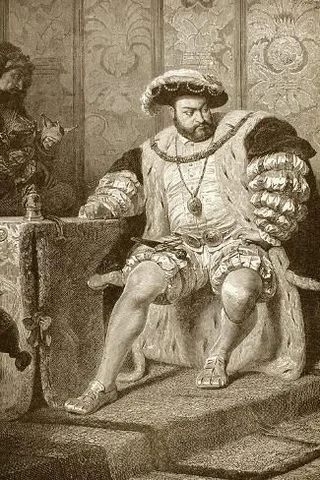 Estbalishes the sovereignty of England. This act makes England fully sovereign in its laws. England is the one who decides on its laws. People could not appeal to the pope to overturn henry the 8th over the church.
Estbalishes the sovereignty of England. This act makes England fully sovereign in its laws. England is the one who decides on its laws. People could not appeal to the pope to overturn henry the 8th over the church. -
 Henry is made head of the church in England.
Henry is made head of the church in England. -
-
 Resistance. Religious and secular motives for the rebellion in the North in 1536 : (after dissolution of monasteries, an unpopular decision)
Resistance. Religious and secular motives for the rebellion in the North in 1536 : (after dissolution of monasteries, an unpopular decision) -
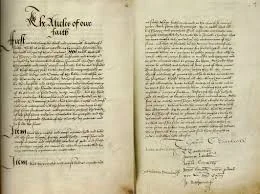 the basis and summary of a true Christian faith. possibly written by Thomas Cranmer.
the basis and summary of a true Christian faith. possibly written by Thomas Cranmer. -
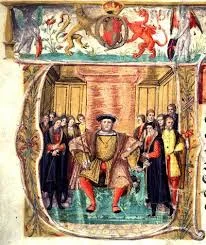 He dissolved the monasteries to make money. Their wealth becomes crown property, it was an unpopular decision.
He dissolved the monasteries to make money. Their wealth becomes crown property, it was an unpopular decision. -
 A translation of the Bible in English is printed in England with royal licence (Coverdale’s Bible).
A translation of the Bible in English is printed in England with royal licence (Coverdale’s Bible). -
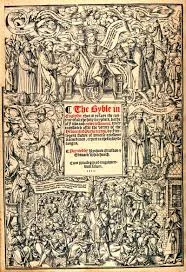 official English translation of the Bible. It was the first authorized edition of the Bible in the English language.
official English translation of the Bible. It was the first authorized edition of the Bible in the English language. -
-
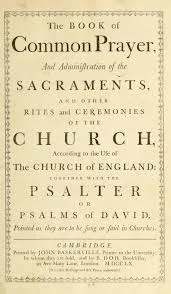 It is a prayer books is the first prayer book, published in 1549 in the reign of King Edward VI of England, it was a product of the English Reformation following the break with Rome.
It is a prayer books is the first prayer book, published in 1549 in the reign of King Edward VI of England, it was a product of the English Reformation following the break with Rome. -
 It required all persons to attend worship on Sunday.
It required all persons to attend worship on Sunday. -
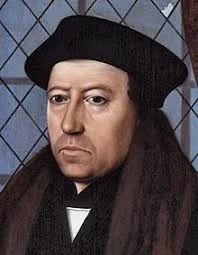 The Forty-two Articles were the official doctrinal statement of the Church of England for a brief period in 1553. Written by Archbishop Thomas Cranmer.
The Forty-two Articles were the official doctrinal statement of the Church of England for a brief period in 1553. Written by Archbishop Thomas Cranmer. -
Daughter of Catherine of Aragon and convinced Catholic.
Edward VI had no Children, Henry the 8th's last wife pushed for her step children to be included in the monarchy. the people wanted Catherine of Aragon’s daughter to be queen. -
 Denying the papal supremacy was a heresy punishable by death.
Denying the papal supremacy was a heresy punishable by death. -
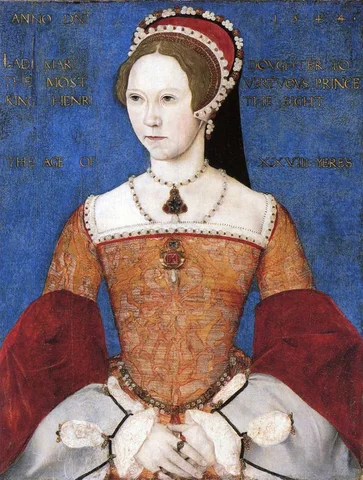 Following the heresy laws, Mary I persecuted Protestants. Archbishop Cranmer was arrested.
Following the heresy laws, Mary I persecuted Protestants. Archbishop Cranmer was arrested.
284 Protestants were executed.
Protestants who were burned at the stake soon became martyrs.
This is why Mary I was given the nickname, 'Bloody Mary' -
Skilled politician, and committed to a strong monarchy.
she wanted to restore religious unity and political stability to England. she also wanted to make England a great power in Europe and the world. -
 The Queen was made Supreme Head of the Church of England.
The Queen was made Supreme Head of the Church of England. -
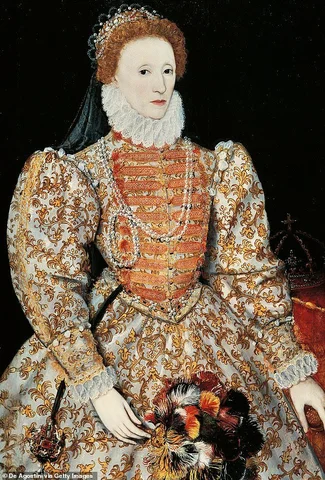 Doctrine of the Church of England and new Prayer book
Doctrine of the Church of England and new Prayer book -
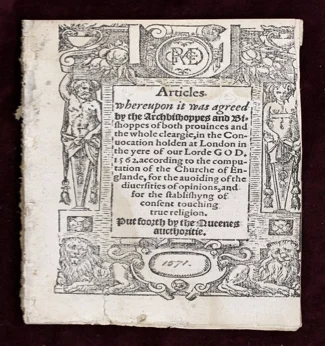 The aim is to establish, in fundamental terms, the faith and practice of the Church of England.
The aim is to establish, in fundamental terms, the faith and practice of the Church of England. -
 Forced the Clergy to assent to the 39 articles.
Forced the Clergy to assent to the 39 articles.
Was a compromise between different religious factions, and Elizabeth’s own religious views. -
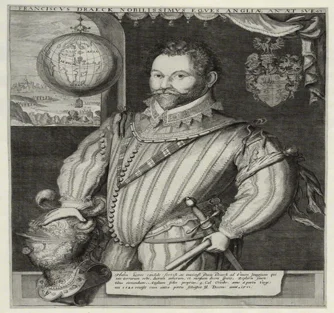 Elizabeth I encouraged expansion:
Elizabeth I encouraged expansion:
Private companies would obtain a Charter, and would develop trade East and West (eg. The East India Company, the Africa Company).
She encouraged the founding of colonies in North America. The first successful was Virginia, in 1607.
This expansion also led to the development of the slave trade (by the Africa Company, among others) -
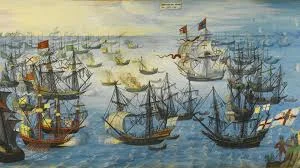 the Spanish Invincible Armada is defeated, but the war drags on at high cost until 1604.
the Spanish Invincible Armada is defeated, but the war drags on at high cost until 1604. -
Theorist of absolute monarchy – tried to avoid Parliamentary interference
King James Bible (1611)
Policy of religious toleration -
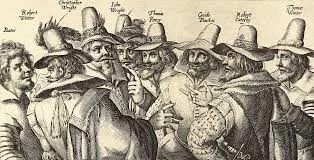 Catholic opposition, Crown toleration of Catholics but popular anti-Catholicism
Catholic opposition, Crown toleration of Catholics but popular anti-Catholicism -
James VI I rules without Parliament
-
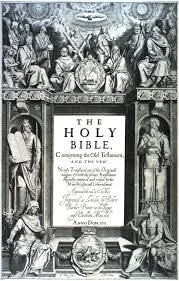
-
Series of intertwined conflicts in the kingdoms of England, Ireland and Scotland (all ruled by Charles I until 1649
-
-
 The petition sought recognition of four principles: no taxation without the consent of Parliament, no imprisonment without cause, no quartering of soldiers on subjects, and no martial law in peacetime
The petition sought recognition of four principles: no taxation without the consent of Parliament, no imprisonment without cause, no quartering of soldiers on subjects, and no martial law in peacetime -
Charles I rules without Parliament.
-
 New model army takeover, marks a big shift. On the first of January parliament votes that parlement is the sole representative of the people and puts Charles on trial. most members of parlement expect Charles to plead guilty and be reprehended.
New model army takeover, marks a big shift. On the first of January parliament votes that parlement is the sole representative of the people and puts Charles on trial. most members of parlement expect Charles to plead guilty and be reprehended. -
 1 December 1641 – Grand Remonstrance
1 December 1641 – Grand Remonstrance
January 1642 – King tries to have 5 leading MPs arrested
22 August 1642 – Charles raises his standard at Nottingham -
 massacres of English Protestants caused by a loss of economic and political power and religious tensions.
massacres of English Protestants caused by a loss of economic and political power and religious tensions. -
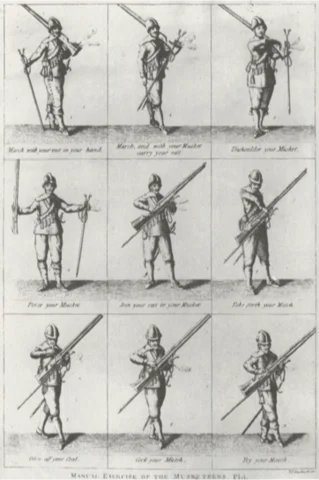 truce between Confederation and Charles’s forces
truce between Confederation and Charles’s forces -
-
The parliament abolished the monarchy and the house of lords. The new Commonwealth tried to implement new policies, but it faced significant difficulties. The regime struggled with legitimacy, as people were concerned about the Puritan dominance that followed. With a Puritan majority in control, there were also tensions within the Commonwealth itself. not for Scotland
-
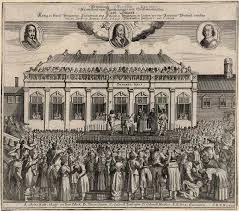
-
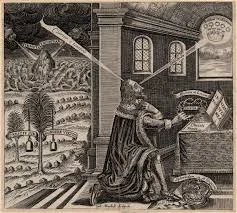 royal portrait, spiritual autobiography attributed to King Charles I of England. It was published on 9 February 1649, ten days after the King was beheaded by Parliament in the aftermath of the English Civil War in 1649.
royal portrait, spiritual autobiography attributed to King Charles I of England. It was published on 9 February 1649, ten days after the King was beheaded by Parliament in the aftermath of the English Civil War in 1649. -
He was king of Scotland in 1649
-
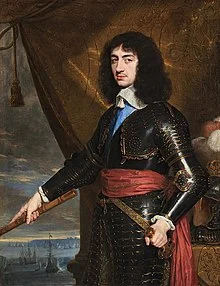 In March 1672 Charles II issued a document to remove harsh sanctions against religious non-conformity
In March 1672 Charles II issued a document to remove harsh sanctions against religious non-conformity -
-
-
 The Bill of Rights 1689 is an Act of the Parliament of England that set out certain basic civil rights and changed the succession to the English Crown. It remains a crucial statute in English constitutional law.
The Bill of Rights 1689 is an Act of the Parliament of England that set out certain basic civil rights and changed the succession to the English Crown. It remains a crucial statute in English constitutional law. -
-
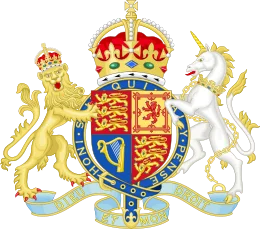 refer to two Acts of Parliament, one by the Parliament of England in 1706, the other by the Parliament of Scotland in 1707. They put into effect the Treaty of Union agreed on 22 July 1706, which merged the previously separate Kingdom of England and Kingdom of Scotland into a single Kingdom of Great Britain, with Queen Anne as its sovereign. The Acts took effect on 1 May 1707, creating the Parliament of Great Britain, based in the Palace of Westminster.
refer to two Acts of Parliament, one by the Parliament of England in 1706, the other by the Parliament of Scotland in 1707. They put into effect the Treaty of Union agreed on 22 July 1706, which merged the previously separate Kingdom of England and Kingdom of Scotland into a single Kingdom of Great Britain, with Queen Anne as its sovereign. The Acts took effect on 1 May 1707, creating the Parliament of Great Britain, based in the Palace of Westminster. -
-
-
The Seven Years' War (1756–1763) was a global conflict involving most of the European great powers, fought primarily in Europe and the Americas. One of the opposing alliances was led by Great Britain and Prussia. The other alliance was led by France and Austria, backed by Spain, Saxony, Sweden, and Russia.
-
